Report on Managing People: Leadership, Training, and Talent Management
VerifiedAdded on 2022/12/23
|9
|2650
|21
Report
AI Summary
This report examines people management strategies within the National Health Service (NHS), focusing on leadership and management, training and development, and talent management. The report explores the operational context of the NHS, which is a large healthcare organization. It discusses relevant theoretical models, such as trait theory, human relation theory, reinforcement theory, and expectancy theory. The report recommends knowledge, skills, and behaviors needed by management in each area, emphasizing the importance of adapting to the challenges posed by the COVID-19 pandemic. The report highlights the significance of training and development to improve skills and abilities and talent management to ensure organizational efficiency and profitability by hiring skilled people with specialized skills. The conclusion summarizes the importance of human resource management in placing the right people and motivating employees to increase productivity. This report provides valuable insights into the challenges and opportunities of managing people in the healthcare sector, particularly in the context of the NHS.
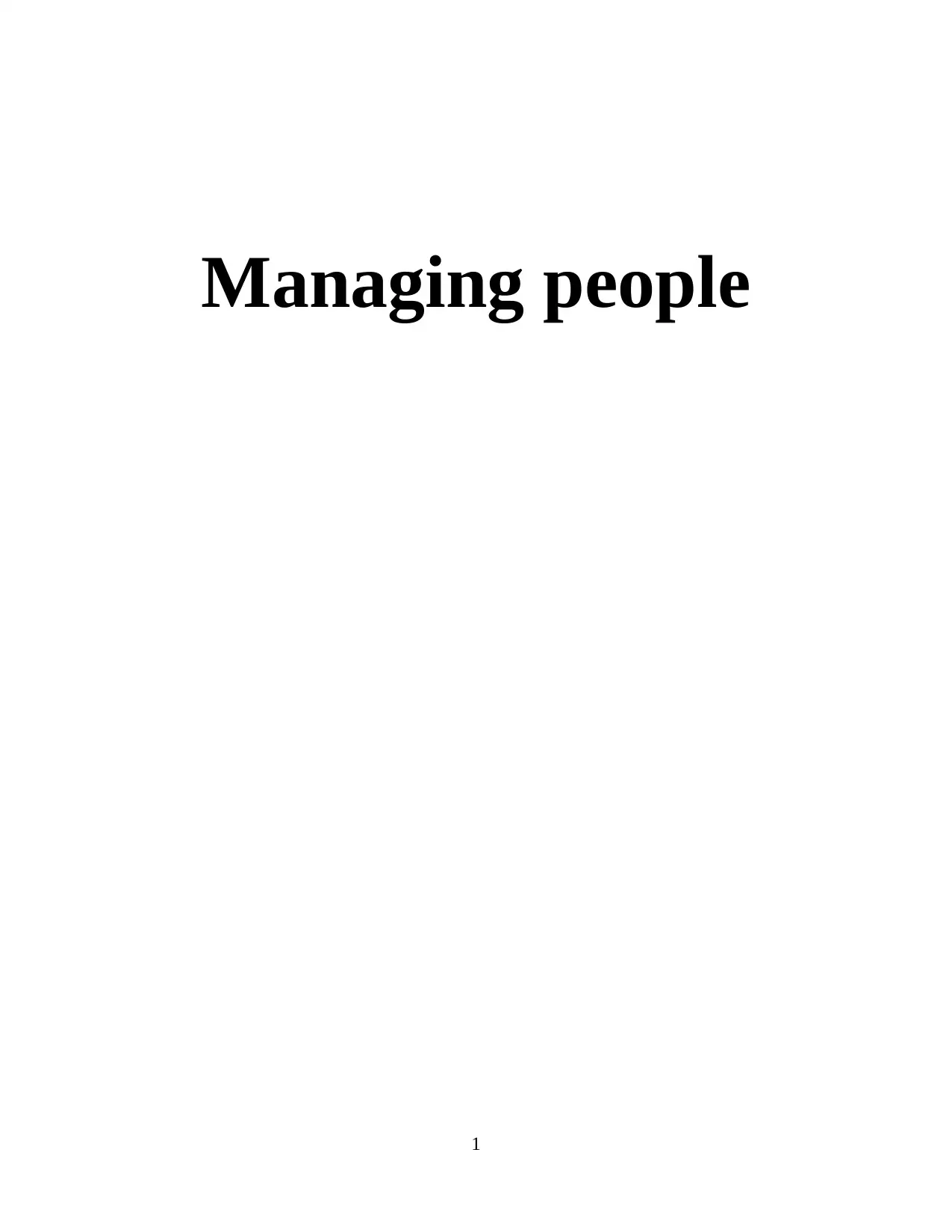
Managing people
1
1
Paraphrase This Document
Need a fresh take? Get an instant paraphrase of this document with our AI Paraphraser
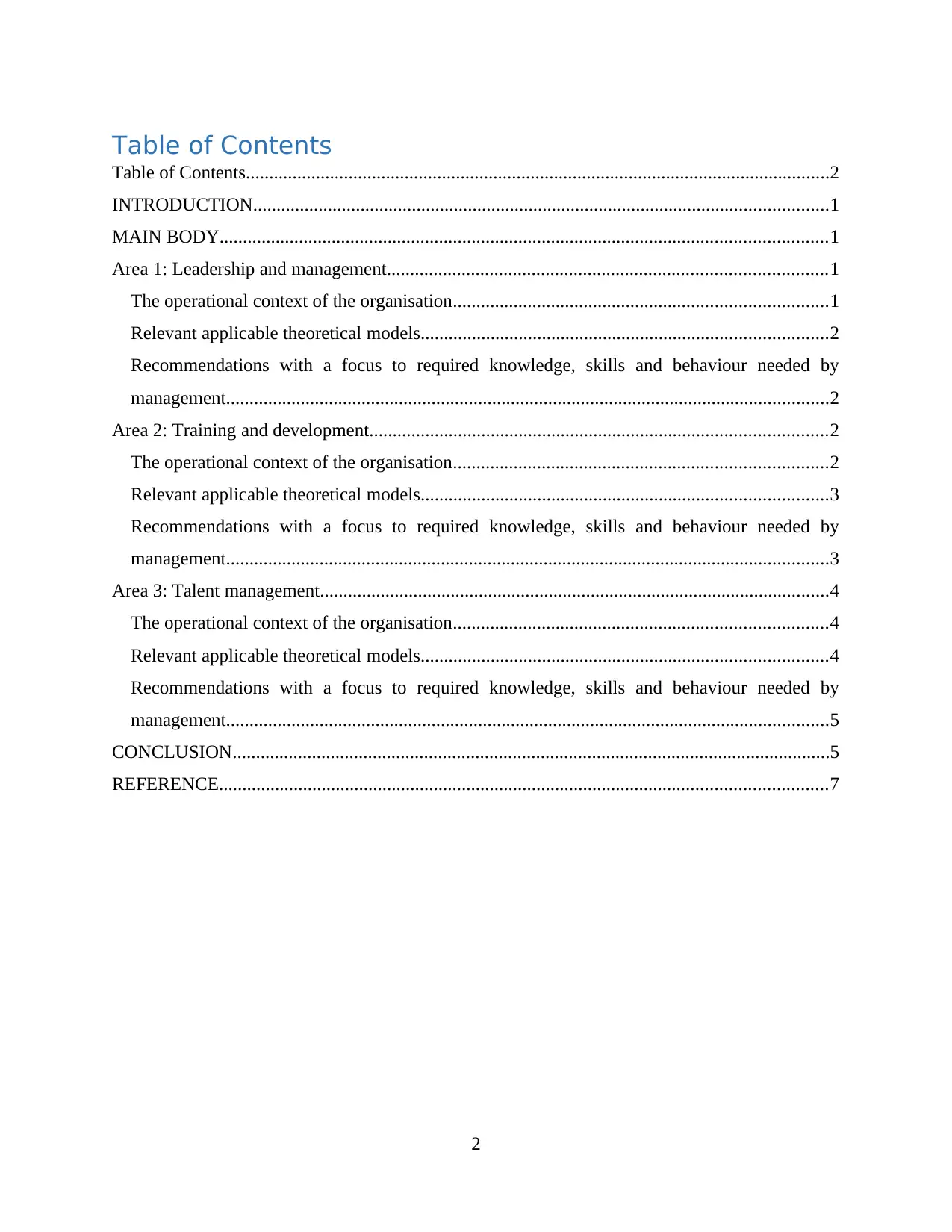
Table of Contents
Table of Contents.............................................................................................................................2
INTRODUCTION...........................................................................................................................1
MAIN BODY..................................................................................................................................1
Area 1: Leadership and management..............................................................................................1
The operational context of the organisation................................................................................1
Relevant applicable theoretical models.......................................................................................2
Recommendations with a focus to required knowledge, skills and behaviour needed by
management.................................................................................................................................2
Area 2: Training and development..................................................................................................2
The operational context of the organisation................................................................................2
Relevant applicable theoretical models.......................................................................................3
Recommendations with a focus to required knowledge, skills and behaviour needed by
management.................................................................................................................................3
Area 3: Talent management.............................................................................................................4
The operational context of the organisation................................................................................4
Relevant applicable theoretical models.......................................................................................4
Recommendations with a focus to required knowledge, skills and behaviour needed by
management.................................................................................................................................5
CONCLUSION................................................................................................................................5
REFERENCE..................................................................................................................................7
2
Table of Contents.............................................................................................................................2
INTRODUCTION...........................................................................................................................1
MAIN BODY..................................................................................................................................1
Area 1: Leadership and management..............................................................................................1
The operational context of the organisation................................................................................1
Relevant applicable theoretical models.......................................................................................2
Recommendations with a focus to required knowledge, skills and behaviour needed by
management.................................................................................................................................2
Area 2: Training and development..................................................................................................2
The operational context of the organisation................................................................................2
Relevant applicable theoretical models.......................................................................................3
Recommendations with a focus to required knowledge, skills and behaviour needed by
management.................................................................................................................................3
Area 3: Talent management.............................................................................................................4
The operational context of the organisation................................................................................4
Relevant applicable theoretical models.......................................................................................4
Recommendations with a focus to required knowledge, skills and behaviour needed by
management.................................................................................................................................5
CONCLUSION................................................................................................................................5
REFERENCE..................................................................................................................................7
2
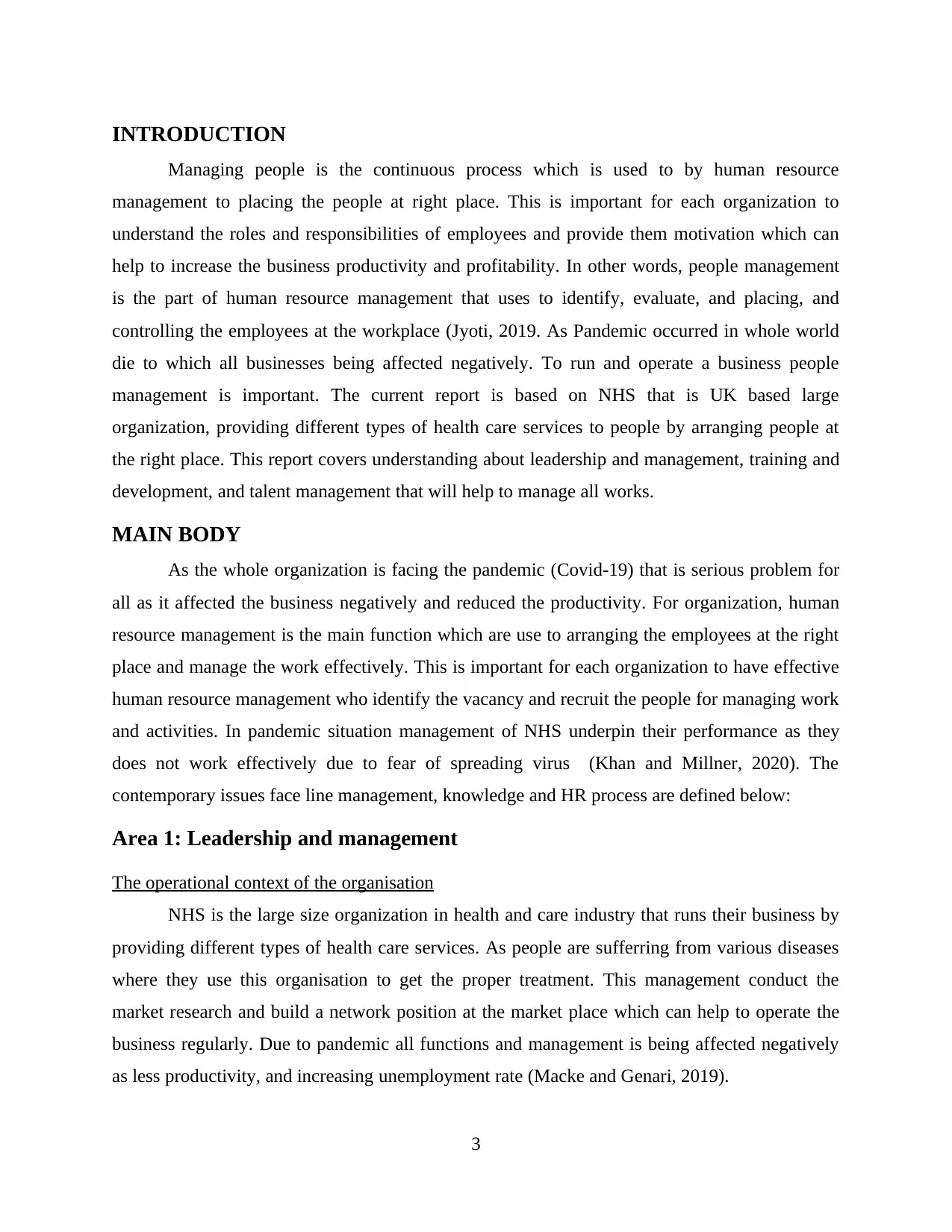
INTRODUCTION
Managing people is the continuous process which is used to by human resource
management to placing the people at right place. This is important for each organization to
understand the roles and responsibilities of employees and provide them motivation which can
help to increase the business productivity and profitability. In other words, people management
is the part of human resource management that uses to identify, evaluate, and placing, and
controlling the employees at the workplace (Jyoti, 2019. As Pandemic occurred in whole world
die to which all businesses being affected negatively. To run and operate a business people
management is important. The current report is based on NHS that is UK based large
organization, providing different types of health care services to people by arranging people at
the right place. This report covers understanding about leadership and management, training and
development, and talent management that will help to manage all works.
MAIN BODY
As the whole organization is facing the pandemic (Covid-19) that is serious problem for
all as it affected the business negatively and reduced the productivity. For organization, human
resource management is the main function which are use to arranging the employees at the right
place and manage the work effectively. This is important for each organization to have effective
human resource management who identify the vacancy and recruit the people for managing work
and activities. In pandemic situation management of NHS underpin their performance as they
does not work effectively due to fear of spreading virus (Khan and Millner, 2020). The
contemporary issues face line management, knowledge and HR process are defined below:
Area 1: Leadership and management
The operational context of the organisation
NHS is the large size organization in health and care industry that runs their business by
providing different types of health care services. As people are sufferring from various diseases
where they use this organisation to get the proper treatment. This management conduct the
market research and build a network position at the market place which can help to operate the
business regularly. Due to pandemic all functions and management is being affected negatively
as less productivity, and increasing unemployment rate (Macke and Genari, 2019).
3
Managing people is the continuous process which is used to by human resource
management to placing the people at right place. This is important for each organization to
understand the roles and responsibilities of employees and provide them motivation which can
help to increase the business productivity and profitability. In other words, people management
is the part of human resource management that uses to identify, evaluate, and placing, and
controlling the employees at the workplace (Jyoti, 2019. As Pandemic occurred in whole world
die to which all businesses being affected negatively. To run and operate a business people
management is important. The current report is based on NHS that is UK based large
organization, providing different types of health care services to people by arranging people at
the right place. This report covers understanding about leadership and management, training and
development, and talent management that will help to manage all works.
MAIN BODY
As the whole organization is facing the pandemic (Covid-19) that is serious problem for
all as it affected the business negatively and reduced the productivity. For organization, human
resource management is the main function which are use to arranging the employees at the right
place and manage the work effectively. This is important for each organization to have effective
human resource management who identify the vacancy and recruit the people for managing work
and activities. In pandemic situation management of NHS underpin their performance as they
does not work effectively due to fear of spreading virus (Khan and Millner, 2020). The
contemporary issues face line management, knowledge and HR process are defined below:
Area 1: Leadership and management
The operational context of the organisation
NHS is the large size organization in health and care industry that runs their business by
providing different types of health care services. As people are sufferring from various diseases
where they use this organisation to get the proper treatment. This management conduct the
market research and build a network position at the market place which can help to operate the
business regularly. Due to pandemic all functions and management is being affected negatively
as less productivity, and increasing unemployment rate (Macke and Genari, 2019).
3
⊘ This is a preview!⊘
Do you want full access?
Subscribe today to unlock all pages.

Trusted by 1+ million students worldwide
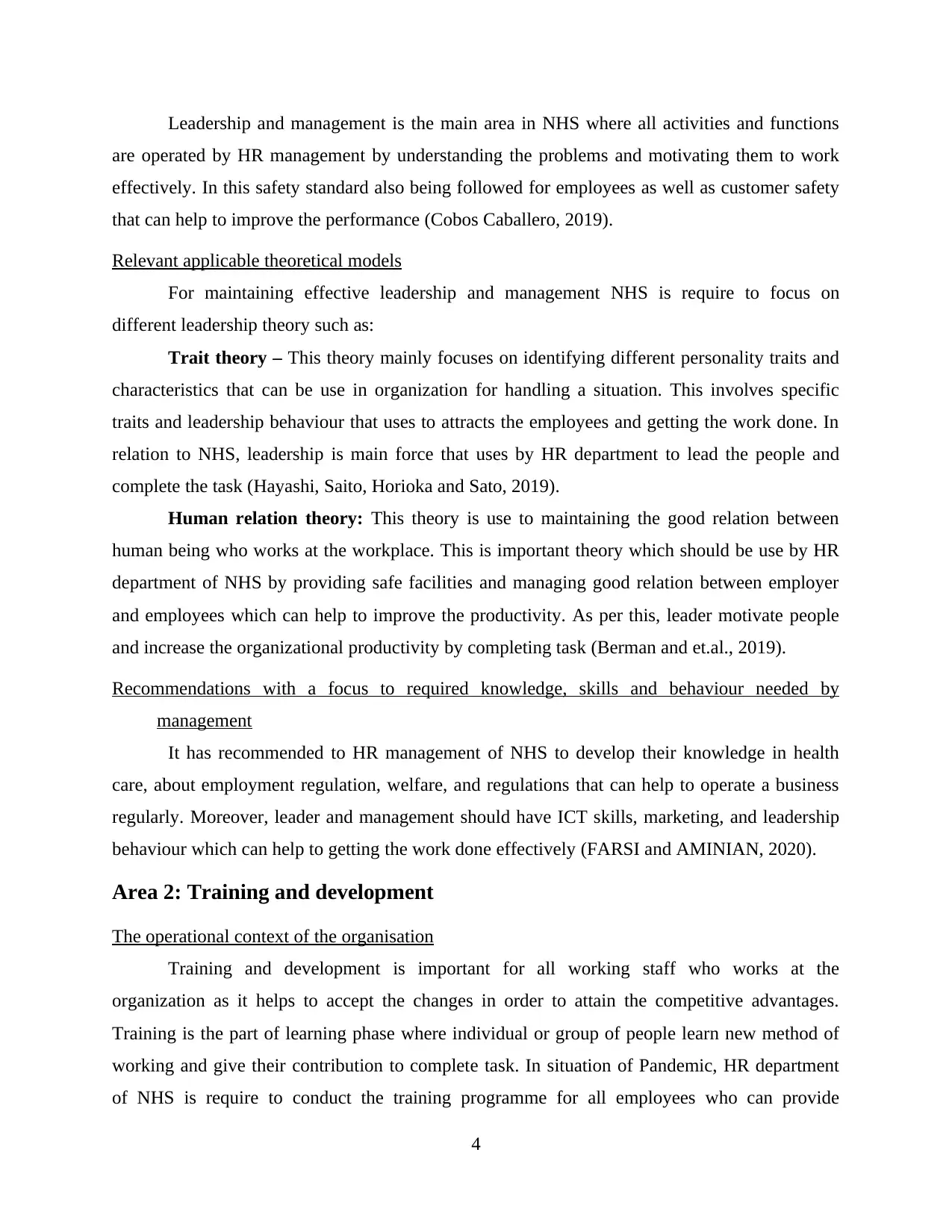
Leadership and management is the main area in NHS where all activities and functions
are operated by HR management by understanding the problems and motivating them to work
effectively. In this safety standard also being followed for employees as well as customer safety
that can help to improve the performance (Cobos Caballero, 2019).
Relevant applicable theoretical models
For maintaining effective leadership and management NHS is require to focus on
different leadership theory such as:
Trait theory – This theory mainly focuses on identifying different personality traits and
characteristics that can be use in organization for handling a situation. This involves specific
traits and leadership behaviour that uses to attracts the employees and getting the work done. In
relation to NHS, leadership is main force that uses by HR department to lead the people and
complete the task (Hayashi, Saito, Horioka and Sato, 2019).
Human relation theory: This theory is use to maintaining the good relation between
human being who works at the workplace. This is important theory which should be use by HR
department of NHS by providing safe facilities and managing good relation between employer
and employees which can help to improve the productivity. As per this, leader motivate people
and increase the organizational productivity by completing task (Berman and et.al., 2019).
Recommendations with a focus to required knowledge, skills and behaviour needed by
management
It has recommended to HR management of NHS to develop their knowledge in health
care, about employment regulation, welfare, and regulations that can help to operate a business
regularly. Moreover, leader and management should have ICT skills, marketing, and leadership
behaviour which can help to getting the work done effectively (FARSI and AMINIAN, 2020).
Area 2: Training and development
The operational context of the organisation
Training and development is important for all working staff who works at the
organization as it helps to accept the changes in order to attain the competitive advantages.
Training is the part of learning phase where individual or group of people learn new method of
working and give their contribution to complete task. In situation of Pandemic, HR department
of NHS is require to conduct the training programme for all employees who can provide
4
are operated by HR management by understanding the problems and motivating them to work
effectively. In this safety standard also being followed for employees as well as customer safety
that can help to improve the performance (Cobos Caballero, 2019).
Relevant applicable theoretical models
For maintaining effective leadership and management NHS is require to focus on
different leadership theory such as:
Trait theory – This theory mainly focuses on identifying different personality traits and
characteristics that can be use in organization for handling a situation. This involves specific
traits and leadership behaviour that uses to attracts the employees and getting the work done. In
relation to NHS, leadership is main force that uses by HR department to lead the people and
complete the task (Hayashi, Saito, Horioka and Sato, 2019).
Human relation theory: This theory is use to maintaining the good relation between
human being who works at the workplace. This is important theory which should be use by HR
department of NHS by providing safe facilities and managing good relation between employer
and employees which can help to improve the productivity. As per this, leader motivate people
and increase the organizational productivity by completing task (Berman and et.al., 2019).
Recommendations with a focus to required knowledge, skills and behaviour needed by
management
It has recommended to HR management of NHS to develop their knowledge in health
care, about employment regulation, welfare, and regulations that can help to operate a business
regularly. Moreover, leader and management should have ICT skills, marketing, and leadership
behaviour which can help to getting the work done effectively (FARSI and AMINIAN, 2020).
Area 2: Training and development
The operational context of the organisation
Training and development is important for all working staff who works at the
organization as it helps to accept the changes in order to attain the competitive advantages.
Training is the part of learning phase where individual or group of people learn new method of
working and give their contribution to complete task. In situation of Pandemic, HR department
of NHS is require to conduct the training programme for all employees who can provide
4
Paraphrase This Document
Need a fresh take? Get an instant paraphrase of this document with our AI Paraphraser
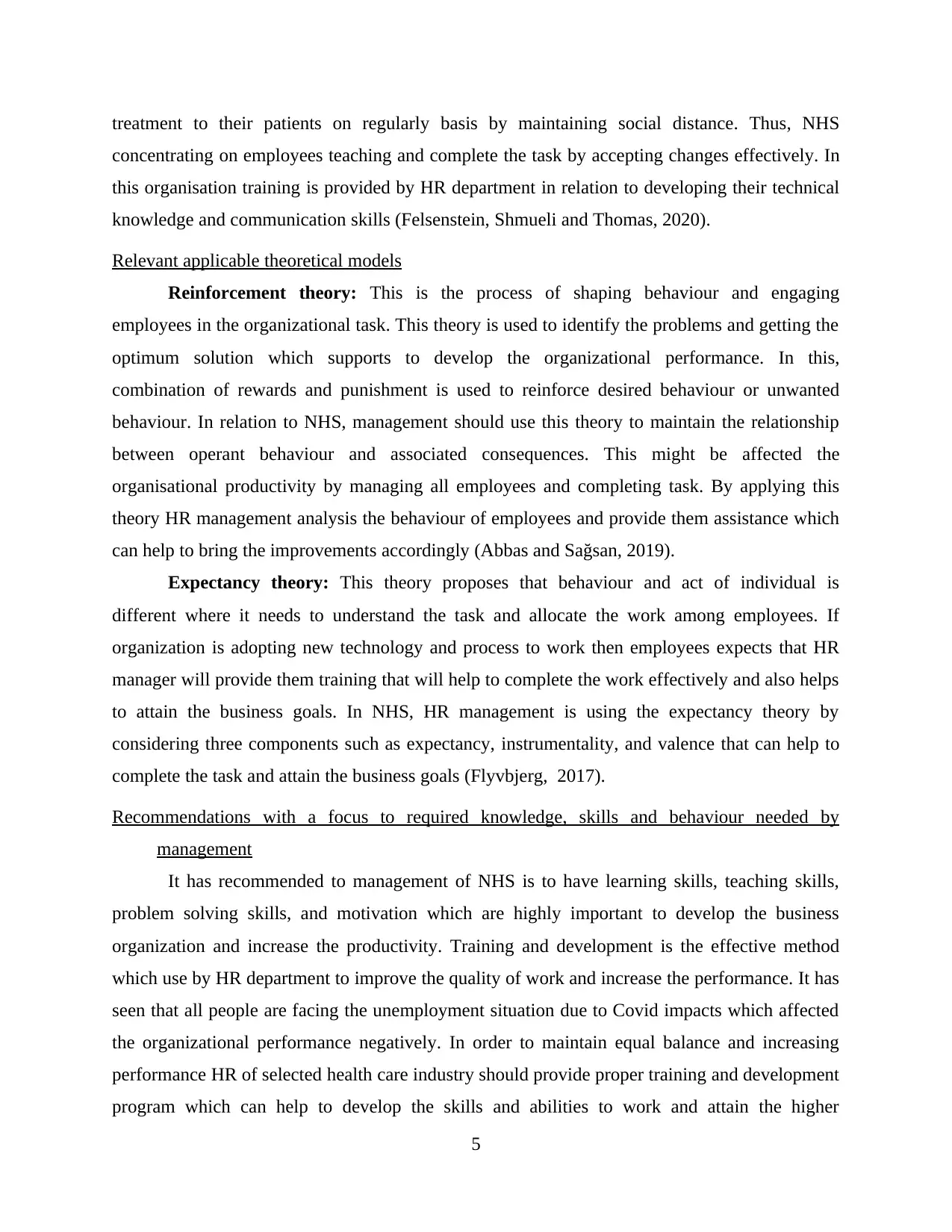
treatment to their patients on regularly basis by maintaining social distance. Thus, NHS
concentrating on employees teaching and complete the task by accepting changes effectively. In
this organisation training is provided by HR department in relation to developing their technical
knowledge and communication skills (Felsenstein, Shmueli and Thomas, 2020).
Relevant applicable theoretical models
Reinforcement theory: This is the process of shaping behaviour and engaging
employees in the organizational task. This theory is used to identify the problems and getting the
optimum solution which supports to develop the organizational performance. In this,
combination of rewards and punishment is used to reinforce desired behaviour or unwanted
behaviour. In relation to NHS, management should use this theory to maintain the relationship
between operant behaviour and associated consequences. This might be affected the
organisational productivity by managing all employees and completing task. By applying this
theory HR management analysis the behaviour of employees and provide them assistance which
can help to bring the improvements accordingly (Abbas and Sağsan, 2019).
Expectancy theory: This theory proposes that behaviour and act of individual is
different where it needs to understand the task and allocate the work among employees. If
organization is adopting new technology and process to work then employees expects that HR
manager will provide them training that will help to complete the work effectively and also helps
to attain the business goals. In NHS, HR management is using the expectancy theory by
considering three components such as expectancy, instrumentality, and valence that can help to
complete the task and attain the business goals (Flyvbjerg, 2017).
Recommendations with a focus to required knowledge, skills and behaviour needed by
management
It has recommended to management of NHS is to have learning skills, teaching skills,
problem solving skills, and motivation which are highly important to develop the business
organization and increase the productivity. Training and development is the effective method
which use by HR department to improve the quality of work and increase the performance. It has
seen that all people are facing the unemployment situation due to Covid impacts which affected
the organizational performance negatively. In order to maintain equal balance and increasing
performance HR of selected health care industry should provide proper training and development
program which can help to develop the skills and abilities to work and attain the higher
5
concentrating on employees teaching and complete the task by accepting changes effectively. In
this organisation training is provided by HR department in relation to developing their technical
knowledge and communication skills (Felsenstein, Shmueli and Thomas, 2020).
Relevant applicable theoretical models
Reinforcement theory: This is the process of shaping behaviour and engaging
employees in the organizational task. This theory is used to identify the problems and getting the
optimum solution which supports to develop the organizational performance. In this,
combination of rewards and punishment is used to reinforce desired behaviour or unwanted
behaviour. In relation to NHS, management should use this theory to maintain the relationship
between operant behaviour and associated consequences. This might be affected the
organisational productivity by managing all employees and completing task. By applying this
theory HR management analysis the behaviour of employees and provide them assistance which
can help to bring the improvements accordingly (Abbas and Sağsan, 2019).
Expectancy theory: This theory proposes that behaviour and act of individual is
different where it needs to understand the task and allocate the work among employees. If
organization is adopting new technology and process to work then employees expects that HR
manager will provide them training that will help to complete the work effectively and also helps
to attain the business goals. In NHS, HR management is using the expectancy theory by
considering three components such as expectancy, instrumentality, and valence that can help to
complete the task and attain the business goals (Flyvbjerg, 2017).
Recommendations with a focus to required knowledge, skills and behaviour needed by
management
It has recommended to management of NHS is to have learning skills, teaching skills,
problem solving skills, and motivation which are highly important to develop the business
organization and increase the productivity. Training and development is the effective method
which use by HR department to improve the quality of work and increase the performance. It has
seen that all people are facing the unemployment situation due to Covid impacts which affected
the organizational performance negatively. In order to maintain equal balance and increasing
performance HR of selected health care industry should provide proper training and development
program which can help to develop the skills and abilities to work and attain the higher
5
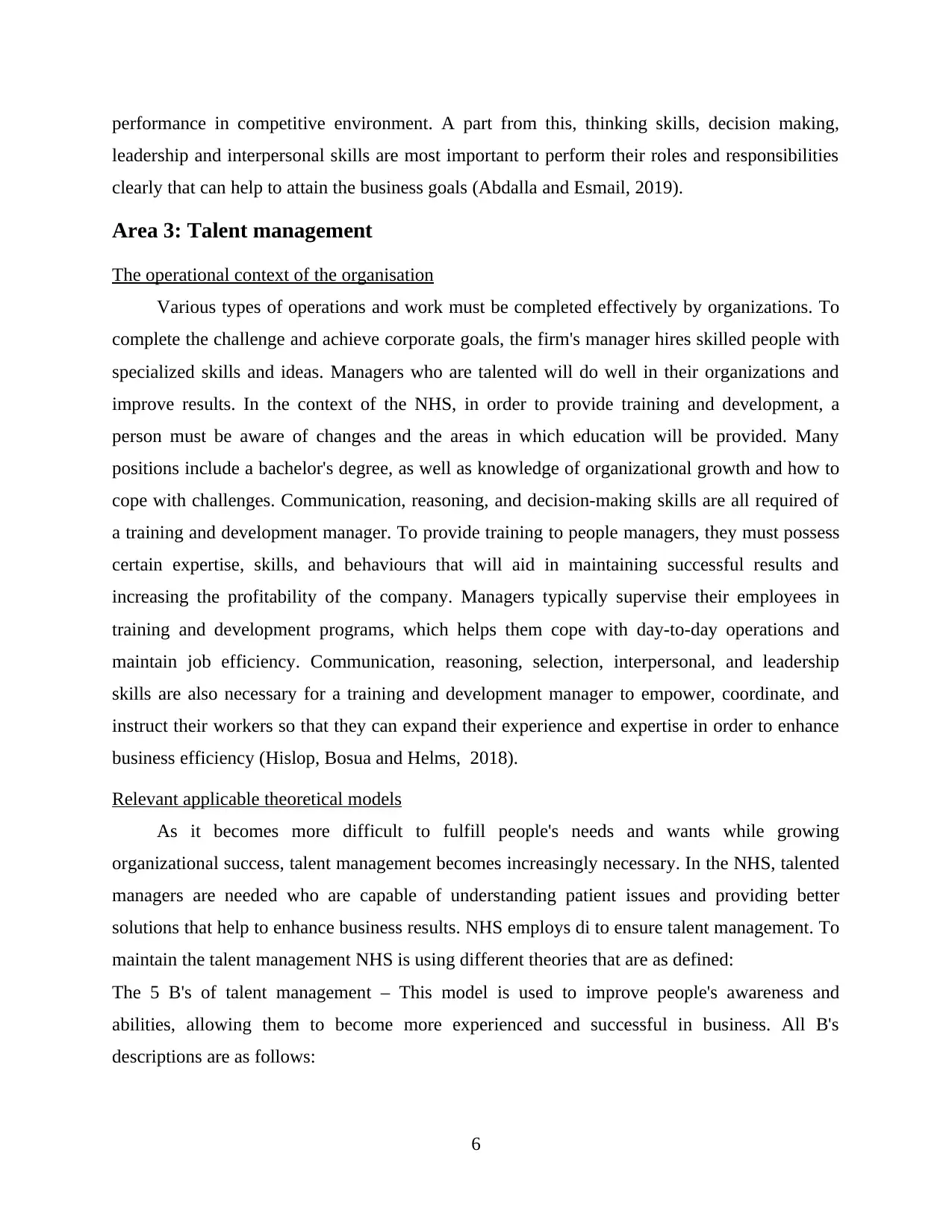
performance in competitive environment. A part from this, thinking skills, decision making,
leadership and interpersonal skills are most important to perform their roles and responsibilities
clearly that can help to attain the business goals (Abdalla and Esmail, 2019).
Area 3: Talent management
The operational context of the organisation
Various types of operations and work must be completed effectively by organizations. To
complete the challenge and achieve corporate goals, the firm's manager hires skilled people with
specialized skills and ideas. Managers who are talented will do well in their organizations and
improve results. In the context of the NHS, in order to provide training and development, a
person must be aware of changes and the areas in which education will be provided. Many
positions include a bachelor's degree, as well as knowledge of organizational growth and how to
cope with challenges. Communication, reasoning, and decision-making skills are all required of
a training and development manager. To provide training to people managers, they must possess
certain expertise, skills, and behaviours that will aid in maintaining successful results and
increasing the profitability of the company. Managers typically supervise their employees in
training and development programs, which helps them cope with day-to-day operations and
maintain job efficiency. Communication, reasoning, selection, interpersonal, and leadership
skills are also necessary for a training and development manager to empower, coordinate, and
instruct their workers so that they can expand their experience and expertise in order to enhance
business efficiency (Hislop, Bosua and Helms, 2018).
Relevant applicable theoretical models
As it becomes more difficult to fulfill people's needs and wants while growing
organizational success, talent management becomes increasingly necessary. In the NHS, talented
managers are needed who are capable of understanding patient issues and providing better
solutions that help to enhance business results. NHS employs di to ensure talent management. To
maintain the talent management NHS is using different theories that are as defined:
The 5 B's of talent management – This model is used to improve people's awareness and
abilities, allowing them to become more experienced and successful in business. All B's
descriptions are as follows:
6
leadership and interpersonal skills are most important to perform their roles and responsibilities
clearly that can help to attain the business goals (Abdalla and Esmail, 2019).
Area 3: Talent management
The operational context of the organisation
Various types of operations and work must be completed effectively by organizations. To
complete the challenge and achieve corporate goals, the firm's manager hires skilled people with
specialized skills and ideas. Managers who are talented will do well in their organizations and
improve results. In the context of the NHS, in order to provide training and development, a
person must be aware of changes and the areas in which education will be provided. Many
positions include a bachelor's degree, as well as knowledge of organizational growth and how to
cope with challenges. Communication, reasoning, and decision-making skills are all required of
a training and development manager. To provide training to people managers, they must possess
certain expertise, skills, and behaviours that will aid in maintaining successful results and
increasing the profitability of the company. Managers typically supervise their employees in
training and development programs, which helps them cope with day-to-day operations and
maintain job efficiency. Communication, reasoning, selection, interpersonal, and leadership
skills are also necessary for a training and development manager to empower, coordinate, and
instruct their workers so that they can expand their experience and expertise in order to enhance
business efficiency (Hislop, Bosua and Helms, 2018).
Relevant applicable theoretical models
As it becomes more difficult to fulfill people's needs and wants while growing
organizational success, talent management becomes increasingly necessary. In the NHS, talented
managers are needed who are capable of understanding patient issues and providing better
solutions that help to enhance business results. NHS employs di to ensure talent management. To
maintain the talent management NHS is using different theories that are as defined:
The 5 B's of talent management – This model is used to improve people's awareness and
abilities, allowing them to become more experienced and successful in business. All B's
descriptions are as follows:
6
⊘ This is a preview!⊘
Do you want full access?
Subscribe today to unlock all pages.

Trusted by 1+ million students worldwide
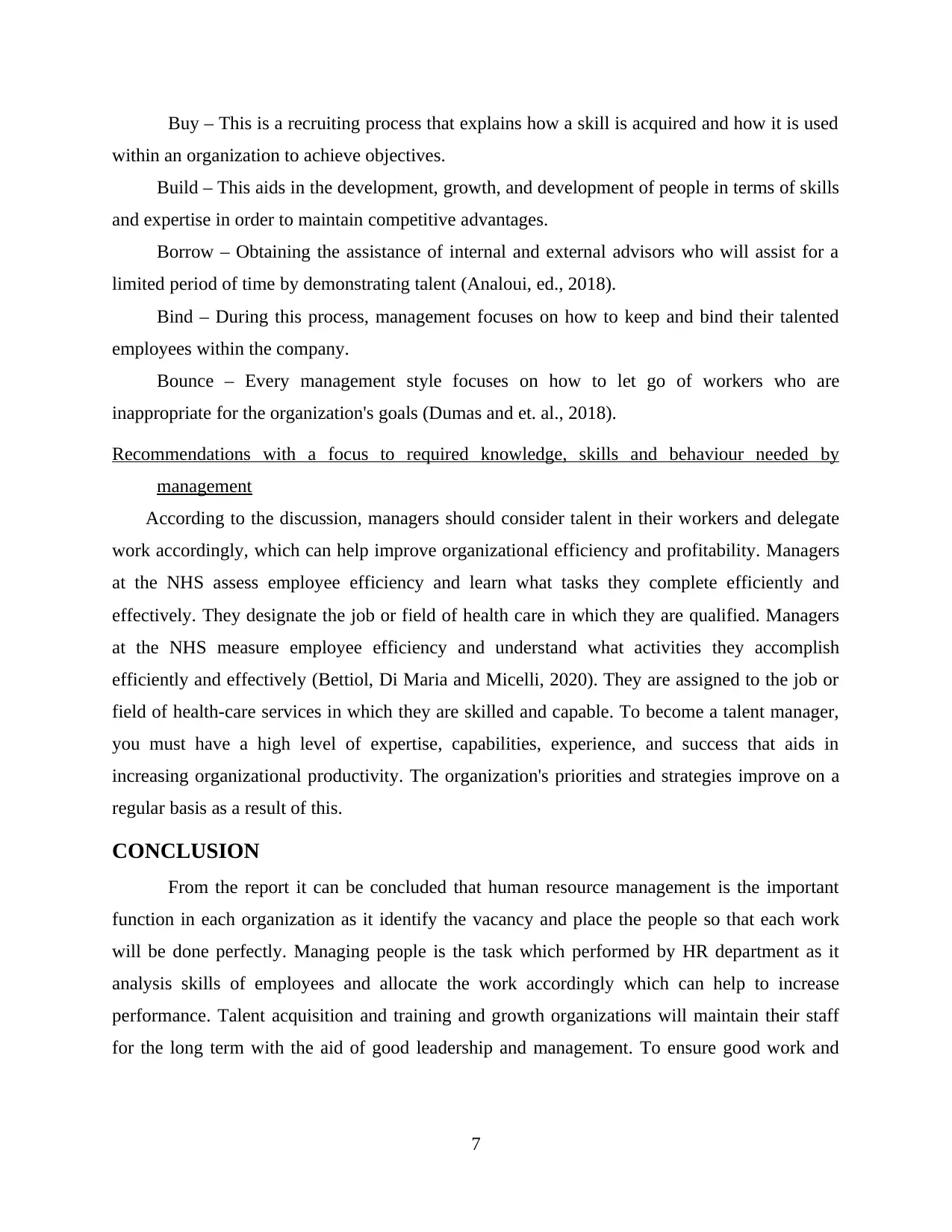
Buy – This is a recruiting process that explains how a skill is acquired and how it is used
within an organization to achieve objectives.
Build – This aids in the development, growth, and development of people in terms of skills
and expertise in order to maintain competitive advantages.
Borrow – Obtaining the assistance of internal and external advisors who will assist for a
limited period of time by demonstrating talent (Analoui, ed., 2018).
Bind – During this process, management focuses on how to keep and bind their talented
employees within the company.
Bounce – Every management style focuses on how to let go of workers who are
inappropriate for the organization's goals (Dumas and et. al., 2018).
Recommendations with a focus to required knowledge, skills and behaviour needed by
management
According to the discussion, managers should consider talent in their workers and delegate
work accordingly, which can help improve organizational efficiency and profitability. Managers
at the NHS assess employee efficiency and learn what tasks they complete efficiently and
effectively. They designate the job or field of health care in which they are qualified. Managers
at the NHS measure employee efficiency and understand what activities they accomplish
efficiently and effectively (Bettiol, Di Maria and Micelli, 2020). They are assigned to the job or
field of health-care services in which they are skilled and capable. To become a talent manager,
you must have a high level of expertise, capabilities, experience, and success that aids in
increasing organizational productivity. The organization's priorities and strategies improve on a
regular basis as a result of this.
CONCLUSION
From the report it can be concluded that human resource management is the important
function in each organization as it identify the vacancy and place the people so that each work
will be done perfectly. Managing people is the task which performed by HR department as it
analysis skills of employees and allocate the work accordingly which can help to increase
performance. Talent acquisition and training and growth organizations will maintain their staff
for the long term with the aid of good leadership and management. To ensure good work and
7
within an organization to achieve objectives.
Build – This aids in the development, growth, and development of people in terms of skills
and expertise in order to maintain competitive advantages.
Borrow – Obtaining the assistance of internal and external advisors who will assist for a
limited period of time by demonstrating talent (Analoui, ed., 2018).
Bind – During this process, management focuses on how to keep and bind their talented
employees within the company.
Bounce – Every management style focuses on how to let go of workers who are
inappropriate for the organization's goals (Dumas and et. al., 2018).
Recommendations with a focus to required knowledge, skills and behaviour needed by
management
According to the discussion, managers should consider talent in their workers and delegate
work accordingly, which can help improve organizational efficiency and profitability. Managers
at the NHS assess employee efficiency and learn what tasks they complete efficiently and
effectively. They designate the job or field of health care in which they are qualified. Managers
at the NHS measure employee efficiency and understand what activities they accomplish
efficiently and effectively (Bettiol, Di Maria and Micelli, 2020). They are assigned to the job or
field of health-care services in which they are skilled and capable. To become a talent manager,
you must have a high level of expertise, capabilities, experience, and success that aids in
increasing organizational productivity. The organization's priorities and strategies improve on a
regular basis as a result of this.
CONCLUSION
From the report it can be concluded that human resource management is the important
function in each organization as it identify the vacancy and place the people so that each work
will be done perfectly. Managing people is the task which performed by HR department as it
analysis skills of employees and allocate the work accordingly which can help to increase
performance. Talent acquisition and training and growth organizations will maintain their staff
for the long term with the aid of good leadership and management. To ensure good work and
7
Paraphrase This Document
Need a fresh take? Get an instant paraphrase of this document with our AI Paraphraser

inspire staff, management and leaders should provide training that will impress employees and
make them feel at ease.
8
make them feel at ease.
8
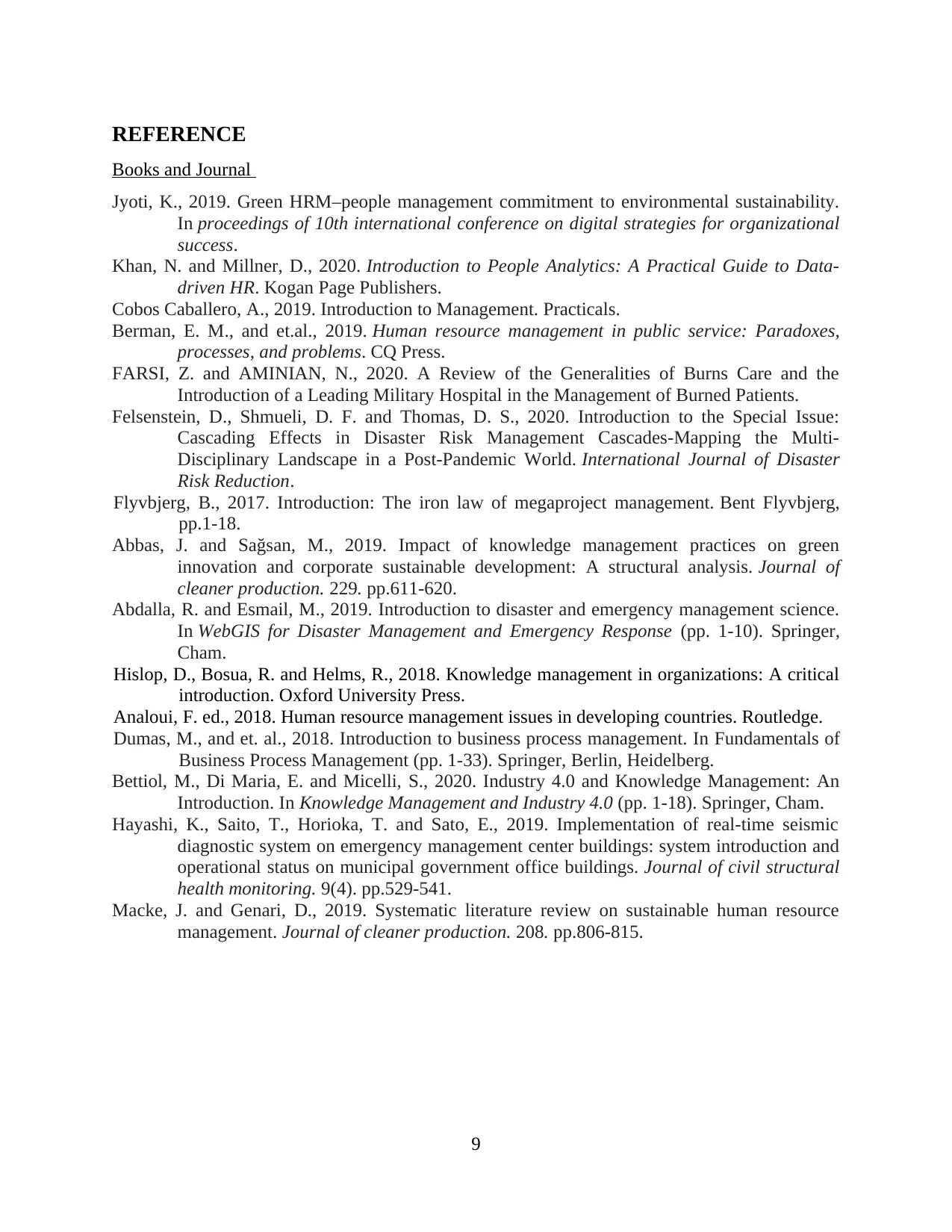
REFERENCE
Books and Journal
Jyoti, K., 2019. Green HRM–people management commitment to environmental sustainability.
In proceedings of 10th international conference on digital strategies for organizational
success.
Khan, N. and Millner, D., 2020. Introduction to People Analytics: A Practical Guide to Data-
driven HR. Kogan Page Publishers.
Cobos Caballero, A., 2019. Introduction to Management. Practicals.
Berman, E. M., and et.al., 2019. Human resource management in public service: Paradoxes,
processes, and problems. CQ Press.
FARSI, Z. and AMINIAN, N., 2020. A Review of the Generalities of Burns Care and the
Introduction of a Leading Military Hospital in the Management of Burned Patients.
Felsenstein, D., Shmueli, D. F. and Thomas, D. S., 2020. Introduction to the Special Issue:
Cascading Effects in Disaster Risk Management Cascades-Mapping the Multi-
Disciplinary Landscape in a Post-Pandemic World. International Journal of Disaster
Risk Reduction.
Flyvbjerg, B., 2017. Introduction: The iron law of megaproject management. Bent Flyvbjerg,
pp.1-18.
Abbas, J. and Sağsan, M., 2019. Impact of knowledge management practices on green
innovation and corporate sustainable development: A structural analysis. Journal of
cleaner production. 229. pp.611-620.
Abdalla, R. and Esmail, M., 2019. Introduction to disaster and emergency management science.
In WebGIS for Disaster Management and Emergency Response (pp. 1-10). Springer,
Cham.
Hislop, D., Bosua, R. and Helms, R., 2018. Knowledge management in organizations: A critical
introduction. Oxford University Press.
Analoui, F. ed., 2018. Human resource management issues in developing countries. Routledge.
Dumas, M., and et. al., 2018. Introduction to business process management. In Fundamentals of
Business Process Management (pp. 1-33). Springer, Berlin, Heidelberg.
Bettiol, M., Di Maria, E. and Micelli, S., 2020. Industry 4.0 and Knowledge Management: An
Introduction. In Knowledge Management and Industry 4.0 (pp. 1-18). Springer, Cham.
Hayashi, K., Saito, T., Horioka, T. and Sato, E., 2019. Implementation of real-time seismic
diagnostic system on emergency management center buildings: system introduction and
operational status on municipal government office buildings. Journal of civil structural
health monitoring. 9(4). pp.529-541.
Macke, J. and Genari, D., 2019. Systematic literature review on sustainable human resource
management. Journal of cleaner production. 208. pp.806-815.
9
Books and Journal
Jyoti, K., 2019. Green HRM–people management commitment to environmental sustainability.
In proceedings of 10th international conference on digital strategies for organizational
success.
Khan, N. and Millner, D., 2020. Introduction to People Analytics: A Practical Guide to Data-
driven HR. Kogan Page Publishers.
Cobos Caballero, A., 2019. Introduction to Management. Practicals.
Berman, E. M., and et.al., 2019. Human resource management in public service: Paradoxes,
processes, and problems. CQ Press.
FARSI, Z. and AMINIAN, N., 2020. A Review of the Generalities of Burns Care and the
Introduction of a Leading Military Hospital in the Management of Burned Patients.
Felsenstein, D., Shmueli, D. F. and Thomas, D. S., 2020. Introduction to the Special Issue:
Cascading Effects in Disaster Risk Management Cascades-Mapping the Multi-
Disciplinary Landscape in a Post-Pandemic World. International Journal of Disaster
Risk Reduction.
Flyvbjerg, B., 2017. Introduction: The iron law of megaproject management. Bent Flyvbjerg,
pp.1-18.
Abbas, J. and Sağsan, M., 2019. Impact of knowledge management practices on green
innovation and corporate sustainable development: A structural analysis. Journal of
cleaner production. 229. pp.611-620.
Abdalla, R. and Esmail, M., 2019. Introduction to disaster and emergency management science.
In WebGIS for Disaster Management and Emergency Response (pp. 1-10). Springer,
Cham.
Hislop, D., Bosua, R. and Helms, R., 2018. Knowledge management in organizations: A critical
introduction. Oxford University Press.
Analoui, F. ed., 2018. Human resource management issues in developing countries. Routledge.
Dumas, M., and et. al., 2018. Introduction to business process management. In Fundamentals of
Business Process Management (pp. 1-33). Springer, Berlin, Heidelberg.
Bettiol, M., Di Maria, E. and Micelli, S., 2020. Industry 4.0 and Knowledge Management: An
Introduction. In Knowledge Management and Industry 4.0 (pp. 1-18). Springer, Cham.
Hayashi, K., Saito, T., Horioka, T. and Sato, E., 2019. Implementation of real-time seismic
diagnostic system on emergency management center buildings: system introduction and
operational status on municipal government office buildings. Journal of civil structural
health monitoring. 9(4). pp.529-541.
Macke, J. and Genari, D., 2019. Systematic literature review on sustainable human resource
management. Journal of cleaner production. 208. pp.806-815.
9
⊘ This is a preview!⊘
Do you want full access?
Subscribe today to unlock all pages.

Trusted by 1+ million students worldwide
1 out of 9
Related Documents
Your All-in-One AI-Powered Toolkit for Academic Success.
+13062052269
info@desklib.com
Available 24*7 on WhatsApp / Email
![[object Object]](/_next/static/media/star-bottom.7253800d.svg)
Unlock your academic potential
Copyright © 2020–2025 A2Z Services. All Rights Reserved. Developed and managed by ZUCOL.





